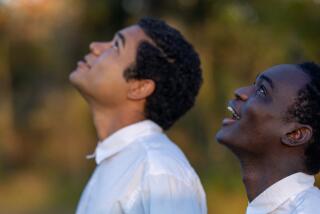A head-spinning back story
- Share via
There’s nothing like lowered expectations to prepare you for a movie.
Since Warner Bros. has consigned “Exorcist: The Beginning” to that category of films that don’t rate an advance screening for critics, and since the production has had such a checkered past, it’s only natural to suppose it might be unwatchable, doomed for future revival on “Mystery Science Theater 3000.”
The prequel to writer William Peter Blatty and director William Friedkin’s pea-soup-spewing, head-spinning 1973 classic “The Exorcist” has traveled a well-documented bumpy road. Interest in the devil-possession franchise was rekindled following the 2000 re-release of an expanded version of Friedkin’s film, and plans moved forward on a new movie, but “The Beginning’s” fate may have been sealed when director John Frankenheimer died in June 2002.
Paul Schrader was brought in to direct; lead actor Liam Neeson left during pre-production and was replaced by Stellan Skarsgard, with shooting finally commencing later that year. Then Schrader’s version of “The Beginning” was rejected by producer James G. Robinson, who hired journeyman director Renny Harlin to replace Schrader and re-shoot virtually the entire film.
Harlin’s effort marks the fourth “Exorcist” film, not counting Schrader’s, and it’s certainly not the worst. Somewhere between a prologue set in the Middle Ages that unintentionally evokes “Life of Brian” and a final shot of Skarsgard walking into what looks like a grade-schooler’s diorama lies a perfectly mediocre horror film. There is some hoot-inducing dialogue and cheesy effects, but the film’s workmanlike narrative marches gamely forward, managing a handful of respectable scares along the way.
“The Beginning” tells the story of the first film’s Father Lankester Merrin (Skarsgard) and his initial rumble with the devil a quarter of a century earlier. Having disavowed the priesthood, he’s working as an archeologist in Cairo just after World War II when he’s recruited by a collector to visit an excavation in Africa and covertly bring back a prized artifact. At the site in then-colonial Kenya, the British army has unearthed a pristine Byzantine church that appears to date to AD 500, or 1,000 years before Christianity supposedly reached the area.
Intrigued, Merrin accepts the assignment and is accompanied by an idealistic young representative of the Vatican, Father Francis (James D’Arcy), who is there to ensure the religious integrity of the dig. The pair arrives at the village near the site of the church only to find that progress on the excavation has ceased. The local Turkana tribe refuses to enter the church, and the head archeologist has gone mad and been sent to a sanitarium.
Still plagued by memories of Nazi atrocities during the war, Merrin attempts to hold on to reason as events in the village worsen. A young boy, Joseph (Remy Sweeney), whom Merrin befriends, seemingly becomes possessed, then falls into a trance after witnessing his older brother get torn to bits by a pack of hyenas. The increasingly supernatural occurrences force Merrin to reconsider his belief that evil is something innately human rather than a dark, omnipresent power. But the profundity the movie seems to strive for is lost in the thicket of special effects and scare moments.
Harlin is a competent action director, and the film builds to an adequately harrowing climax in which the filmmakers bring out the real heavy artillery, mainly crucifixes, holy water and a book of Roman rituals. For the most part it’s a satisfyingly knock-down, drag-out clash with blunt theological overtones, equal parts WWE, Beetlejuice and Dr. Gene Scott.
Skarsgard rises to the occasion, stepping smoothly into the role of Father Merrin so memorably played by Max von Sydow in the 1973 original. Their shared ruddy complexion and Scandinavian features make them a good physical match. D’Arcy has the more thankless role, playing the stereotypically righteous representative of the Catholic Church, with the centuries of baggage that entails.
Cinematographer Vittorio Storaro, a three-time Oscar winner, has created a dusty palette of earth tones that gives the film the look of being projected onto parchment. Much of the film was shot on the back lots of Italy’s Cinecitta Studios and thus features state-of-the-art digital effects -- which, unfortunately, still means that some things work and others don’t. Some backdrops have a painterly quality, while many of the desert vistas look left over from “The Mummy.” The digital hyenas are about as terrifying as sock puppets.
Meanwhile, reports circulate that the Schrader version will soon surface. Until then, this chapter of the legacy of “The Exorcist” remains open.
*
‘Exorcist: The Beginning’
MPAA rating: R for strong violence and gore, disturbing images and rituals, and for language including some sexual dialogue
Times guidelines: At least one rung higher on the grotesque scale than an episode of “Fear Factor,” including an especially nasty scene of childbirth.
Stellan Skarsgard...Father Merrin
James D’Arcy...Father Francis
Izabella Scorupco...Sarah
Remy Sweeney...Joseph
Julian Wadham...Major Granville
A Morgan Creek production, released by Warner Bros. Director Renny Harlin. Producer James G. Robinson. Executive producers Guy McElwaine, David C. Robinson. Screenplay by Alexi Hawley, story by William Wisher and Caleb Carr. Cinematographer Vittorio Storaro. Editors Mark Goldblatt, Todd E. Miller. Costume designer Luke Reichle. Music Trevor Rabin. Production designer Stefano Ortolani. Art director Eugenio Ulissi. Set decorator Carlo Gervasi. Running time: 1 hour, 54 minutes.
In general release.
More to Read
Only good movies
Get the Indie Focus newsletter, Mark Olsen's weekly guide to the world of cinema.
You may occasionally receive promotional content from the Los Angeles Times.











